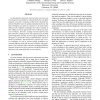148 search results - page 6 / 30 » Soft-Error Detection through Software Fault-Tolerance Techni... |
DSN
2006
IEEE
14 years 1 months ago
2006
IEEE
As chip densities and clock rates increase, processors are becoming more susceptible to transient faults that can affect program correctness. Computer architects have typically ad...
COMPSAC
2005
IEEE
14 years 1 months ago
2005
IEEE
This paper demonstrates our Web Service based NVersion model, WS-FTM (Web Service-Fault Tolerance Mechanism), which applies this well proven technique to the domain of Web Service...
IWSEC
2009
Springer
14 years 2 months ago
2009
Springer
Abstract. Common software-protection systems attempt to detect malicious observation and modification of protected applications. Upon tamper detection, anti-hacking code may produ...
EDCC
2006
Springer
13 years 11 months ago
2006
Springer
The importance of fault tolerance at the processor architecture level has been made increasingly important due to rapid advancements in the design and usage of high performance de...
CODES
2009
IEEE
14 years 2 months ago
2009
IEEE
Time redundancy (rollback-recovery) and hardware redundancy are commonly used in real-time systems to achieve fault tolerance. From an energy consumption point of view, time redun...

